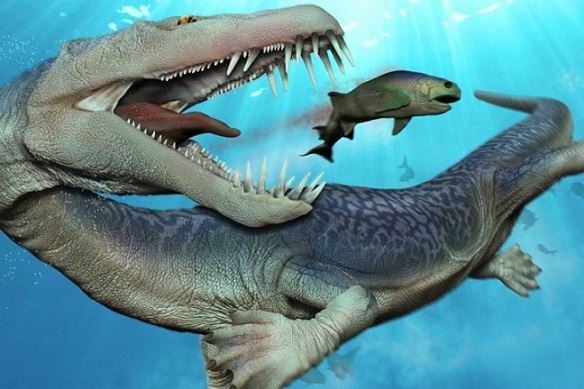DINOSAURS: Under the Waves

IMAGE SOURCE
While the dinosaurs dominated the land, the ocean was the domain of families of marine reptiles, such as notosaurs, ichthyosaurs, pliosaurs, mosasaurids and elasmosaurs. They were carnivores and hunted other sea creatures, as well as each other. Although these reptiles spent their lives in the water, they could not remain under the waves indefinitely. They breathed air and had to swim to the surface to fill their lungs, before disappearing again underwater.
SNAKE NECK
Elasmosaurus was a member of the long-necked elasmosaur family. This sea giant had 72 vertebrae on its serpent neck and its light skull had fierce intertwined teeth. Elasmosaurus means "lizard with plaque" refers to the large shoulder blades as plates that covered chest and formed the gaps in their arms. The huge muscles that moved the fins were fixed to these bones.

IMAGE SOURCE
PREDATOR WITH FANGS
The Nothosaurus belonged to a family of small predatory amphibians, the notosaurs. His neck was long and flexible and his teeth like fangs and ranged in the jaw to the cheeks. He swam moving his powerful front legs and used the hind legs to control the direction. Fossils were found in marine rocks in Europe and the Near East, suggesting they were marine creatures that fed on land.

IMAGE SOURCE
JURASSIC SHARK
As another member of the ichthyosaurid family, the Ictiosaurus had a shark body. Fossils found in England and Germany indicate that this marine reptile had a triangular dorsal fin, two pairs of fins and a forked vertical tail like that of a shark. In some fossils pigment cells survive and indicate that the skin was reddish brown.

IMAGE SOURCE
MARINE LIZARD
The Tylosaurus was a giant mosasaur with a long skull, from a family related to the ground lizards like the gila monsters. One of the most distinctive features of the Tylosaurus was a hard, bone-like point on the muzzle and this indicates that it was used as a weapon to attack its prey. All the mosasaurs had tooth teeth on the palate and in the jaws.

IMAGE SOURCE
GIANTS OF THE SOUTHERN MARES
With a 3-m (10-foot) skull and long and huge sharp teeth, the Kronosaurus was one of the largest pliosaurs with short necks. Carnivoro fierce, hunted other marine reptiles and lived in the seas that today surround Australia and South America. The large muscles of its fins gave it a powerful boost. Maybe while one pair of fins moved down, the other pair moved up.

IMAGE SOURCE
A curious article about the ancient creatures that live under the waters, an interesting subject that led me to show you all of you. Thanks for reading me.


Good thing all those "monsters" are not extinct!
I would like to share with you an advice that I hope you can appreciate, and it is to always include the references for your article at the end of it. Just a gentle recommendation pal.
Cheers!
Good afternoon greetings.
thanks for the suggestion, this article does not have as reference any article on the internet, only the photos are taken from the internet and I put the source of the image. But I will place at the end of the article the encyclopedia from which I take the ideas.